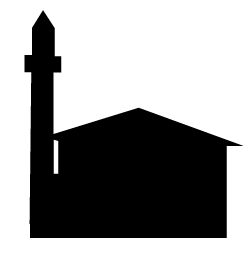Agara
Agara Mosque
Although rich with surviving historic carvings and murals, the most striking element of Agara’s interior is a more recent addition: large stencils of palm trees, applied with spray paint, ringing the walls. This unusual reference to the Adjara region’s balmy Black Sea coast seems out of place in a mountain village, but a similar mural (of earlier, perhaps even pre-Soviet, vintage) also appears on a nearby house exterior. Most of these new designs accommodate or embellish, rather than paint over, earlier work. Other original elements, including the carved minbar, mihrab frame, door, and balcony, are typical of the template-based applied wooden ornament popular during the late Russian Imperial era. Vinyl panels cover the entire ceiling except for the dome, the only element of the mosque with its original paintings left entirely untouched. The wreaths, flowers, and tasseled swags of fabric are all motifs common to domes of the period. Less usual is the central ring of red banners with white stars and crescents, a reference to the Ottoman (later Turkish) flag. While rare in Adjara, this motif is often found on domes in the neighboring region of Akhaltsikhe, once home to a distinct (but also Sunni Muslim) community of Muslim Meskhetians.* Agara’s dome resembles those found at the formerly Meskhetian Turkish villages of Orgora, Persa, and Sakuneti, and is nearly identical to one at Zikilia (hijri date 1317, or 1900). These close similarities could suggest that Laz craftsmen also had ties with Muslim communities beyond Adjara.
*This community, debatably comprised of either “Turkified” ethnic Georgians or ethnic Turkish settlers, resided in present-day southwestern Georgia (an Ottoman territory from the sixteenth century). Soviet authorities deported the Meskhetian Turks to Central Asia in 1944 and repopulated their villages with ethnic Georgians, who left any mosques abandoned.
DISTRICT: Khulo
LOCATION: 41°41’48.4”N 42°23’16.5”E
POPULATION: 497
CONSTRUCTION DATE: 1903
RENOVATION DATE(S): 1990s
CRAFTSMEN: Unknown Laz masters
MINARET : Yes

